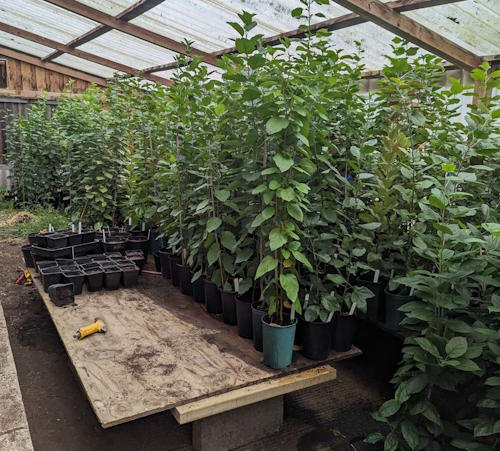 Seedling trees
Seedling treesIn 2024, I decided it was time to step up my breeding program. I had another batch of close to 600 seeds to germinate - “2023 seedlings”- and I was determined to improve my growing methods.
I learnt from a generous former employee from East Malling Research station (NIAB EMR) that you could further reduce the juvenile stage of a seedling apple tree by growing the tree as fast as possible. Essentially if you could grow a 2m tree under glass in 1 season you set yourself up with a good chance that the wood at the tip would be fruiting adult material.
In apple breeding, time is precious and I calculated it was worth investing in some serious kit, so I set up my own heated grow room. Everything went to plan and I am now in a position of waiting to see what difference my efforts will make over the next few seasons as I compare the 2023 and 2021 seedling batches.
2024 was also the first season in which I decided to attempt hand pollination, where you select both parents of the seed by fertilising flowers with collected pollen. Up until this point I had let nature take its course - how could I possibly know what crosses worked best out of the approximate 244,650 potential crosses possible using our collection of 700 named varieties (699(699+1)2) ?
Previously I had used three seed parents, selected because they were good apples, and knowing how meiosis works, their offspring were likely to share some of their good characteristics. Apples as a crop are widely varied - there was relatively little genetic bottle-necking and so we have a huge gene pool, as is obvious from the expression of so much wonderful variation. There are apples in July, apples in January, tiny apples the size of plums and huge apples the size of small melons.
Every seedling I have seen is new and unique, some are clearly a variation of their seed parent. Using genetic analysis I have been able to find out the pollen parents of many of my best seedlings including 73, 77 and 82. The findings were comforting, the pollen parents were all good apples themselves and I could immediately see how the combination of the two had created the seedling. I have not yet studied a large group of seedling siblings (with the same parents) but I am now interested to see what the variation within the group will be.
Hand pollination is a tricky endeavour, it involves precise timing and lots of planning. Pollen needs to be collected, bags need to placed on tree branches to exclude interfering pollinators, the weather needs to be above 15 degrees and then any surviving labelled fruits need to be collected and separated from others. Lots can go wrong, so it is common to have a lower than expected success rate … so I am grateful that despite my best efforts I have yet again landed on about 600 “2024 seedling” seeds. These seeds are a combination of over 50 successful crosses and are, as I write this, germinating in the heated grow room. I don’t know if the crosses I am attempting are the best choices, time will tell. I am confident that viewing a large range of crosses at this early stage will eventually lead me on the right track. You don’t know until you try it… and you must take lots of notes!
Whilst 2024 was a breakthrough season for my breeding methods, there were also several successes from the “2015 seedlings”. A further 20 seedlings had fruited which again included several new interesting apples and a couple of vastly improved scores for apples fruiting in their second or third year.
Seedling 73 had regained its flavour and I felt confident about selling it alongside the consistently well performing seedling 77, so both of these became available for customers to buy under the trademarked names of Hamid’s Red Pippin® and Bethan® respectively., and I will be releasing seedling 82 under the trademark Primrose Pippin® for winter 2025/26.
With a further 1800 seedlings in the “2021 seedlings”, “2023 seedlings” and “2024 seedlings”, I am expecting to have dozens of new exclusive varieties to offer customers in the 2030s. Every season, I dedicate more and more of my time to apple breeding. There are very few apple breeders in the UK and nearly no others with the same freedom which I have with regards to direction. I accept that commercial breeding is very important and it requires tens of thousands of seedlings from the same 2 chosen parents and over 20 years of breeding and trials to create something new which the fruit and commerce industry wants to get behind. Supermarkets have very specific storage and appearance requirements and every characteristic of a variety has a financial implication for growers who are willing to attempt to grow it. I am breeding for my own pleasure and for the pleasure of those who love apples. I want to create new exciting apples which will become favourites in gardens up and down the country. I have learnt that breeding the perfect apple is impossible - people like different apples - therefore creating a range of superb new varieties will be my goal.
 British-grown fruit trees
British-grown fruit trees